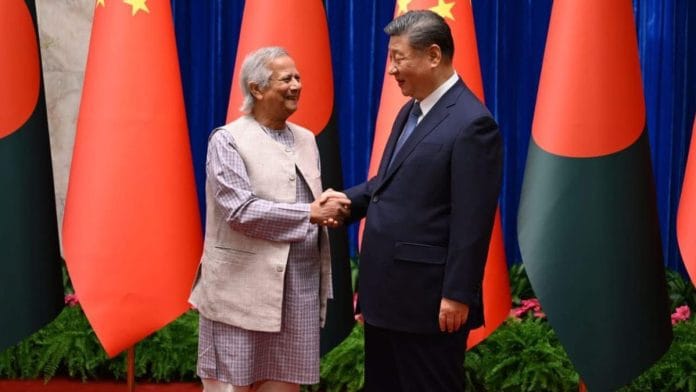For China, Muhammad Yunus’s recent visit to Beijing signals a strategic opportunity to reshape its relationship with Bangladesh. Under the leadership of former Prime Minister Sheikh Hasina, China often viewed Bangladesh as being within India’s strategic orbit, limiting the scope for deeper engagement. The interim government’s Chief Adviser is seen as a more promising partner, capable of unlocking significant economic and infrastructural cooperation, positioning China at the heart of Bangladesh’s evolving regional and global ambitions.
Contrasting approaches to China
Yunus’ visit is perceived as a turning point in Bangladesh’s foreign policy.
One Chinese commentator noted that Hasina’s tenure saw her closely aligned with India, sometimes to the extent of being perceived as subservient to Indian interests. Where Hasina’s alignment with India limited the potential for deeper ties with China, Yunus’ government is seen as offering a more open and pragmatic approach. A common view among Chinese discourse is that China’s financial and technical expertise could help Bangladesh address its economic challenges, positioning Beijing as a crucial partner in the country’s growth. In contrast to India’s strategic influence in South Asia, China’s principle of non-interference and focus on regional cooperation present a more attractive model for Bangladesh’s development aspirations.
Qian Feng, director of the research department and senior research fellow at the National Strategy Institute at Tsinghua University, sees Yunus’ visit as a signal of the interim government’s intent to advance ties with China, especially on economic cooperation. Lin Minwang, Professor at the Center for South Asian Studies, Institute of Strategic Studies and International Security, Fudan University, notes that while Hasina favoured India, Yunus’ leadership could usher in a new era of stronger engagement with Beijing, aided by the Bangladesh Nationalist Party’s historical openness to China.
Liu Zongyi of the Shanghai Institute of International Studies highlights that despite Bangladesh’s political fluidity, there is broad domestic willingness to engage with China. He points out that under Hasina, projects such as deep-water seaports were outsourced to countries without sufficient construction capacity, stifling Bangladesh’s growth. In contrast, Yunus’s government could better align with China’s Belt and Road Initiative, boosting infrastructure development.
Also read: Yunus has done the impossible in Bangladesh—brought arch-rivals Awami League and BNP closer
India’s central role
China’s relationship with Bangladesh cannot be viewed separately from its broader South Asia strategy, where India remains central.
India’s anxieties about China’s growing presence in Bangladesh—especially in infrastructure and port development—are noted in Chinese discussions. The “death triangle”—spanning Bangladesh, Sri Lanka (Hambantota), and Pakistan (Gwadar)—is often discussed as a counter to India’s dominance in South Asia. Additionally, unresolved issues like the Teesta River dispute are seen as factors that have drawn Bangladesh closer to China.
Chinese analysts argue that China’s model, which focuses on infrastructure investment without political strings, positions Beijing as Bangladesh’s most reliable economic partner, while India is seen as an obstacle to Bangladesh’s full economic potential.
This bonhomie appears largely transactional, with Bangladesh seeking economic relief amid its crisis and China aiming to reshape South Asian geopolitics while directly challenging India. It aligns with China’s broader strategy of keeping India contained within its own region. As part of this, China plans to invest US$ 400 million to upgrade Bangladesh’s port and allocate US$ 350 million to expand its economic and industrial zone—securing Yunus’ loyalty in return.
Yunus delivered what China wanted. From reaffirming the One China policy to referencing India’s northeastern states, his government signalled a growing alignment with and preference for Beijing over New Delhi. Some Chinese analysts argue that the deepening China-Bangladesh relationship is a cause for concern in India, particularly regarding major projects like the Teesta River and the Port of Bengal. However, despite these assurances, the view remains that Bangladesh will continue balancing its ties with both China and India, avoiding complete alignment with either side.
Also read: Divide and rule, siding with radicals—Yunus has learned what will keep him in power
China seizing the moment
With Yunus now leading, China perceives a more open and pragmatic partner, less constrained by the geopolitical balancing act of the past. Beijing highlights that, unlike India, it offers economic and infrastructural cooperation without political conditions, making it an attractive development partner for Bangladesh.
The key question is no longer whether China will increase its influence in Bangladesh, but how quickly and to what extent. However, in the longer term, Bangladesh’s geographical and strategic constraints will likely necessitate continued engagement with India.
While China might seize the opportunity in Hasina’s absence, attempting to replace India’s role, such a strategy may not be feasible for Bangladesh in the long run. The reality remains: India is still a major power in the region, and playing against it may suit China but not Bangladesh. While a change in government in Bangladesh offers China an opportunity to expand its footprint and influence in South Asia, for the countries in the region, it may come with a cost.
Sana Hashmi is a fellow at the Taiwan-Asia Exchange Foundation. She tweets @sanahashmi1. Views are personal.
(Edited by Theres Sudeep)






